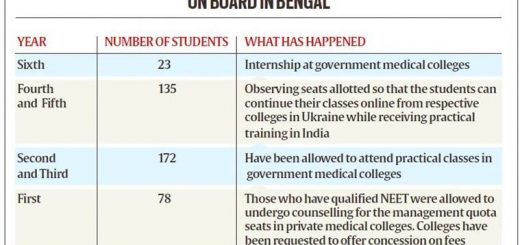Post-Roe landscape could further stress America’s crumbling child care system
In 2008, researchers at the University of California, San Francisco launched a study to track the effects of being denied an abortion on women who sought to end their pregnancies. For five years, they monitored the socioeconomic and health-related outcomes of around 1,000 women who tried to attain an abortion between 2008 and 2010; some received abortions, while others were turned away because their pregnancies were just over a clinic’s gestational limit.
The outcomes captured by The Turnaway Study were clear. Women who gave birth after being denied an abortion experienced an increase in household poverty compared to those who received an abortion. They were more likely to lack food and housing, incur debt, stay in contact with a violent partner and end up raising children alone. The well-being of children was also impacted: Babies born after a mother sought an abortion were more likely to live below the federal poverty level, and the mother’s existing children received lower scores on child development evaluations.
Now, experts are turning to this research and similar studies to anticipate what lies ahead for families in the wake of the Supreme Court’s June ruling in Dobbs v. Jackson Women’s Health Organization, overturning Roe v. Wade. While it’s impossible to predict the full impact this ruling will have on families, if what women experience after Dobbs tracks with the findings of The Turnaway Study and similar findings from other studies, experts say more families will be needing social supports at a time when those supports are already severely lacking. This could further burden the nation’s collapsing and severely underfunded child care system. Hope for aid vanished late last month when Congress eliminated billions of dollars in funding for child care from a stripped-down reconciliation package that replaces President Joe Biden’s Build Back Better plan.

Early childhood advocates have called on lawmakers to restore child care funding to the proposal when the Senate debates the bill this weekend, cautioning that failure to add such funds could be devasting for the child care industry and families.
Paying for child care will be one of many challenges for families affected by bans on abortion, said Julie Kashen, a senior fellow and director for women’s economic justice at The Century Foundation, a progressive think tank. “The outcomes of the post-Roe decision are horrifying,” Kashen said. “We have a completely inadequate safety net and completely inadequate public investment in the care economy, so if you start on that really shaky foundation … you are really just exacerbating existing challenges,” she said.
“When you talk about the burden to child care systems or social safety net or support systems, [women are] having children when they’re less financially stable. And we will see this sort of play out over many years.”
Gretchen Sisson, a sociologist and researcher at Advancing New Standards in Reproductive Health, a research program at the University of California, San Francisco.
While some studies have predicted a “dramatic increase” in births due to bans on abortion, researchers say the reality is more nuanced. Parents may not end up having more children than they intended, but the children they do have will be born at a less opportune time. That means women “are having children on a timeline that they are not dictating,” when they may not be ready, said Gretchen Sisson, a sociologist and researcher at Advancing New Standards in Reproductive Health, a research program at UC, San Francisco.
“When you talk about the burden to child care systems or social safety net or support systems, [women are] having children when they’re less financially stable. And we will see this sort of play out over many years,” Sisson said. “This impact on timing makes people more reliant on public support and assistance. You also will have more children raised in families that are below the poverty level and vulnerable.”
As it stands now, America’s child care system is woefully unprepared to take on more children who need public support to pay for their care. Only 11.6 percent of eligible children received child care subsidies from their states to help pay for care in 2019, and even families who don’t need public subsidies are struggling to find child care, especially for infants and toddlers. A 2020 report found that there were only enough licensed child care slots to provide care for 23 percent of infants and toddlers. And that was before 16,000 child care programs nationwide closed due to the pandemic, a 9 percent decline in licensed providers. The cost of child care has also increased over the past few years, by an average of 41 percent, an amount that is likely to prove burdensome for many families, and especially prohibitive to those in lower income brackets.
Related: After mass closures, too little support, post-pandemic child care options will be scarce
In May, Sens. Patty Murray and Tim Kaine, both Democrats, proposed a plan to increase federal funding for child care. When that plan — or any funding for child care — was left out of the recent reconciliation package, Sen. Murray released a statement calling it “even more urgent” to lower child care costs “with our child care sector on the brink of collapse — and now with Republicans forcing women to give birth no matter their circumstance.”
In recent weeks, some Republican lawmakers in various states have proposed “pro-family” initiatives, such as giving cash stipends to working families, paid parental leave and reforms and more funding for a federal program that provides food and resources for low-income pregnant and postpartum women and their children. In Mississippi, state Rep. Becky Currie, a Republican who wrote the state’s legislation to ban abortion, told the nonprofit news outlet Mississippi Today that she wants the state to provide birth control through local health clinics, but acknowledged that some lawmakers are standing in the way of proposals that would help women. Some experts say such proposals do not go far enough to help families.
Based on existing data on the child care shortage, the authors of a recent column published by the Brookings Institution predict a massive dearth of child care in the wake of new bans on abortion. Even if birth rates, overall, remain stable, the rise in the number of unplanned births could leave the country short nearly 3 million spaces for early child care within three years, wrote researchers Kathy Hirsh-Pasek, Margaret Burchinal and Roberta Michnick Golinkoff. “This shortage will fall disproportionately on families of color and on those who live beneath the poverty line, making it even more unlikely that underserved families will be able to escape a cycle of poverty without strong government intervention,” they added.

Governmental support for families in poverty already falls short of need. The percentage of families in poverty receiving cash assistance through the federal Temporary Assistance for Needy Families (TANF) program has declined since the program was enacted in 1996, according to a report released earlier this year. State rules vary greatly in how families qualify for the aid and how easily families can apply, meaning access to the program can depend on where a family lives.
In the absence of federal support for child care, some states and cities have stepped up to try to stabilize the industry. Recent initiatives in Washington and New Mexico, for example, aim, respectively, to improve pay for child care workers and make child care more affordable for families. Boston mayor Michelle Wu recently signed an executive order demanding real estate developers pay $100 per square foot of building space toward child care in the city, or provide their own child care space onsite.
Related: States stuck trying to fix early ed pay as feds drop the ball
For the most part, voters support such initiatives, especially those that are federally funded. A July survey by Morning Consult found 58 percent of respondents think the federal government has a responsibility to provide child care assistance to families now that Roe v. Wade has been overturned. More than half of the survey takers also believe the government should provide financial assistance to families. Some states and cities have tried to provide financial assistance by using broad anti-poverty programs — such as a guaranteed income program — to provide support to mothers or families with young children, reducing the burdens of meeting basic needs and child -related costs.
Only 11.6 percent of eligible children received child care subsidies from their states to help pay for care in 2019.
Kashen, of The Century Foundation, and Sisson, the sociologist, both agree that widespread, federally-driven support for families is crucial, especially because local and state-led efforts may not reach families that have thin social safety nets already. Some of the states and municipalities that offer the least support for families with children have also enacted the most stringent laws and bans on abortion. (A recent New York Times analysis found states that have banned or are likely to ban abortion tend to have the weakest social services and their residents face worse health and well-being outcomes.)
Widely available, subsidized child care will be critical to support families impacted by abortion bans, Sisson said, as will initiatives that provide affordable housing. If the federal government fails to invest in and shore up nationwide social supports for families in need, she worries that the job of helping those families will fall to social networks, rather than public support systems. “I don’t expect a lot of these states that are banning abortion prohibitively to really come through and deliver with the support that families need,” she said. “I think it’s going to come interpersonally or from kinship circles. Otherwise, I don’t know where it will come from in a really sustainable way.”
This story about post-Roe childcare was produced by The Hechinger Report, a nonprofit, independent news organization focused on inequality and innovation in education. Sign up for Hechinger’s newsletter.



